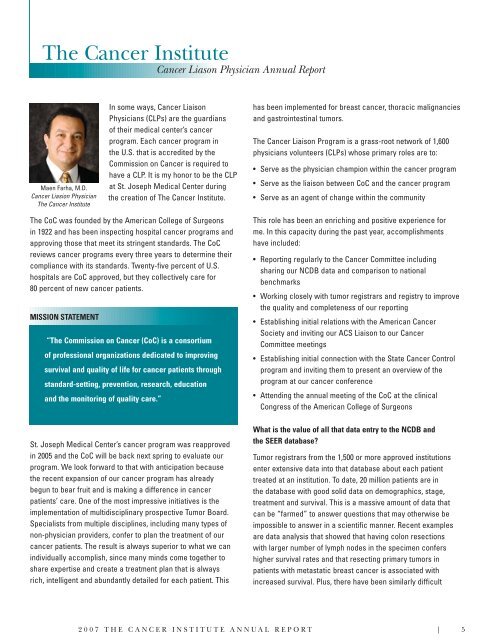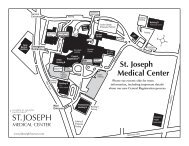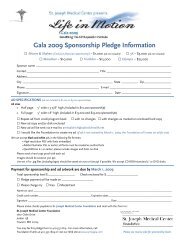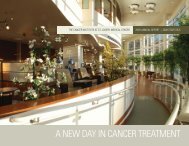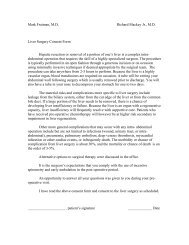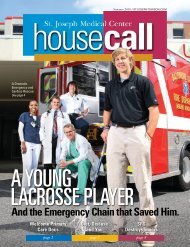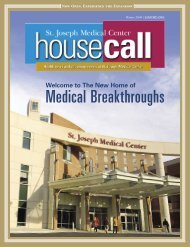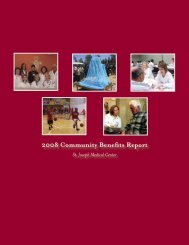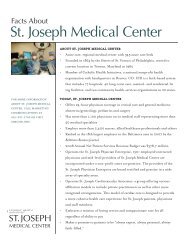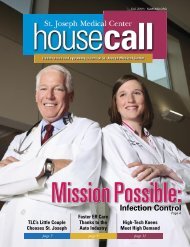2007 Cancer Annual_prod5 - St. Joseph Medical Center
2007 Cancer Annual_prod5 - St. Joseph Medical Center
2007 Cancer Annual_prod5 - St. Joseph Medical Center
You also want an ePaper? Increase the reach of your titles
YUMPU automatically turns print PDFs into web optimized ePapers that Google loves.
The <strong>Cancer</strong> Institute<br />
<strong>Cancer</strong> Liason Physician <strong>Annual</strong> Report<br />
Maen Farha, M.D.<br />
<strong>Cancer</strong> Liasion Physician<br />
The <strong>Cancer</strong> Institute<br />
In some ways, <strong>Cancer</strong> Liaison<br />
Physicians (CLPs) are the guardians<br />
of their medical center’s cancer<br />
program. Each cancer program in<br />
the U.S. that is accredited by the<br />
Commission on <strong>Cancer</strong> is required to<br />
have a CLP. It is my honor to be the CLP<br />
at <strong>St</strong>. <strong>Joseph</strong> <strong>Medical</strong> <strong>Center</strong> during<br />
the creation of The <strong>Cancer</strong> Institute.<br />
has been implemented for breast cancer, thoracic malignancies<br />
and gastrointestinal tumors.<br />
The <strong>Cancer</strong> Liaison Program is a grass-root network of 1,600<br />
physicians volunteers (CLPs) whose primary roles are to:<br />
• Serve as the physician champion within the cancer program<br />
• Serve as the liaison between CoC and the cancer program<br />
• Serve as an agent of change within the community<br />
The CoC was founded by the American College of Surgeons<br />
in 1922 and has been inspecting hospital cancer programs and<br />
approving those that meet its stringent standards. The CoC<br />
reviews cancer programs every three years to determine their<br />
compliance with its standards. Twenty-five percent of U.S.<br />
hospitals are CoC approved, but they collectively care for<br />
80 percent of new cancer patients.<br />
MISSION STATEMENT<br />
“The Commission on <strong>Cancer</strong> (CoC) is a consortium<br />
of professional organizations dedicated to improving<br />
survival and quality of life for cancer patients through<br />
standard-setting, prevention, research, education<br />
and the monitoring of quality care.”<br />
<strong>St</strong>. <strong>Joseph</strong> <strong>Medical</strong> <strong>Center</strong>’s cancer program was reapproved<br />
in 2005 and the CoC will be back next spring to evaluate our<br />
program. We look forward to that with anticipation because<br />
the recent expansion of our cancer program has already<br />
begun to bear fruit and is making a difference in cancer<br />
patients’ care. One of the most impressive initiatives is the<br />
implementation of multidisciplinary prospective Tumor Board.<br />
Specialists from multiple disciplines, including many types of<br />
non-physician providers, confer to plan the treatment of our<br />
cancer patients. The result is always superior to what we can<br />
individually accomplish, since many minds come together to<br />
share expertise and create a treatment plan that is always<br />
rich, intelligent and abundantly detailed for each patient. This<br />
This role has been an enriching and positive experience for<br />
me. In this capacity during the past year, accomplishments<br />
have included:<br />
• Reporting regularly to the <strong>Cancer</strong> Committee including<br />
sharing our NCDB data and comparison to national<br />
benchmarks<br />
• Working closely with tumor registrars and registry to improve<br />
the quality and completeness of our reporting<br />
• Establishing initial relations with the American <strong>Cancer</strong><br />
Society and inviting our ACS Liaison to our <strong>Cancer</strong><br />
Committee meetings<br />
• Establishing initial connection with the <strong>St</strong>ate <strong>Cancer</strong> Control<br />
program and inviting them to present an overview of the<br />
program at our cancer conference<br />
• Attending the annual meeting of the CoC at the clinical<br />
Congress of the American College of Surgeons<br />
What is the value of all that data entry to the NCDB and<br />
the SEER database?<br />
Tumor registrars from the 1,500 or more approved institutions<br />
enter extensive data into that database about each patient<br />
treated at an institution. To date, 20 million patients are in<br />
the database with good solid data on demographics, stage,<br />
treatment and survival. This is a massive amount of data that<br />
can be “farmed” to answer questions that may otherwise be<br />
impossible to answer in a scientific manner. Recent examples<br />
are data analysis that showed that having colon resections<br />
with larger number of lymph nodes in the specimen confers<br />
higher survival rates and that resecting primary tumors in<br />
patients with metastatic breast cancer is associated with<br />
increased survival. Plus, there have been similarly difficult<br />
<strong>2007</strong> THE CANCER INSTITUTE ANNUAL REPORT | 5


